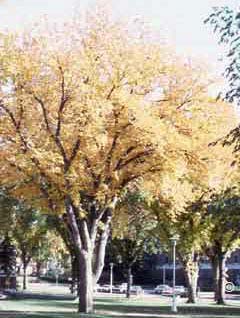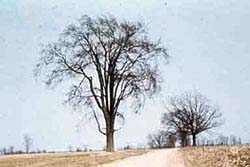
Elm trees, Ulmus spp., tolerate some of the most extreme growing conditions. They thrive where most other trees fail and are widely planted as landscape and street trees. In the early 1900s, the American elm was symbolic of the urban landscape. Many towns had an Elm Street and an elm tree was usually planted on every main street.
What are common species of elm trees?
The two most common elms in Colorado are the American, Ulmus americana, and Siberian, Ulmus pumila. American elms grow to 70 feet tall and have a vase-like branching habit. Mature elms grown as street trees arch together and form a continuous canopy over the streets. Entire streets were planted in American elm because of this attractive growth habit.
What is dutch elm disease?
This mass planting practice, however, has contributed to Dutch elm disease which has meant the demise of most of these stately trees. Dutch elm disease is a widespread and often fatal disease to American elm trees. It is often spread from tree to tree through roots that have grown together. Aphids, scale, leaf miners and elm leaf beetle are common insects that also plague American elms.
What is the difference between Siberian and Chinese elms?
 The Siberian and Chinese elms are often confused. The Chinese elm, Ulmus parvifolia, matures to 30 to 40 feet and only grows in southeastern Colorado where it is warmer. The Siberian elm is a larger tree, growing to 60 to 70 feet tall. It has upright branching and leaves that are less than two inches long. Siberian elms are brittle and their branches are prone to breakage. Dutch elm disease does not affect Siberian elms but insects common on Siberian elm include leaf miner and elm leaf beetle.
The Siberian and Chinese elms are often confused. The Chinese elm, Ulmus parvifolia, matures to 30 to 40 feet and only grows in southeastern Colorado where it is warmer. The Siberian elm is a larger tree, growing to 60 to 70 feet tall. It has upright branching and leaves that are less than two inches long. Siberian elms are brittle and their branches are prone to breakage. Dutch elm disease does not affect Siberian elms but insects common on Siberian elm include leaf miner and elm leaf beetle.
Are there trees that are resistant to dutch elm disease?
Varieties of American elms that are resistant to Dutch elm disease are being developed. Different elm species imported from China are being used to create resistant varieties which should be available in the next few years. In spite of their problems, the elm continues to be of interest to gardeners.
For more information, see the following Colorado State University Extension fact sheet(s).
- Bacterial Wetwood
- Cytospora Canker
- Aphids on Shade Trees and Ornamentals
- Elm Leaf Beetles
- Shade Tree Borers
- Insect Control: Horticultural Oils
For more information, see the following Planttalk Colorado™ video(s).



